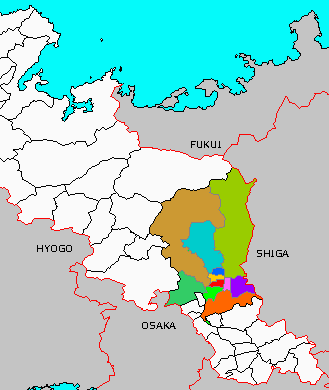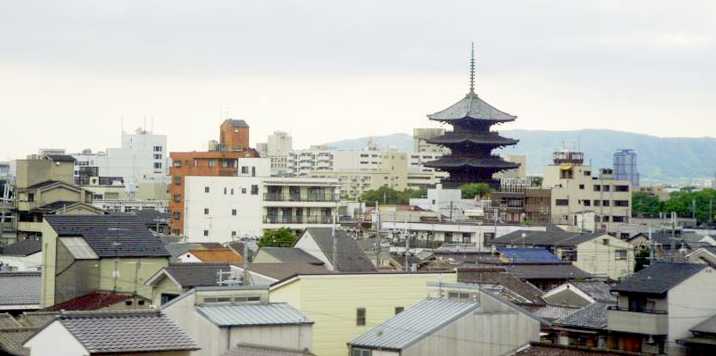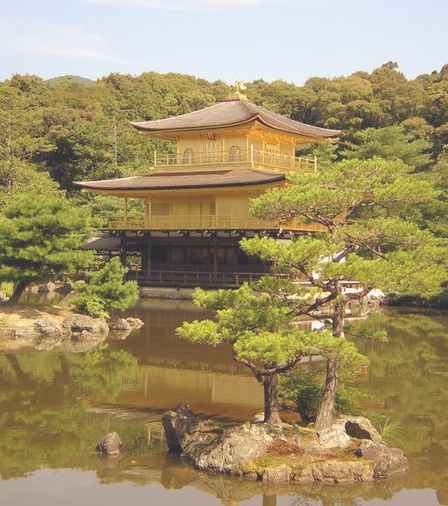|
KYOTO
Please use our A to Z INDEX to navigate this site
|
|||
|
Kyōto (京都市, Kyōto-shi) (lit. “capital capital,” or “capital of capitals”) is a city in Japan, which has a population close to 1.5 million. Formerly the imperial capital of Japan, it is now the capital of Kyoto Prefecture, as well as a major part of the Osaka-Kobe-Kyoto metropolitan area.
Kyoto's location map, Japan
History
Though archaeological evidence places the first human settlement on the islands of Japan to approximately 10,000 BC, relatively little is known about human activity in the area before the 6th century AD. During the 8th century, when the powerful Buddhist clergy became meddlesome in the affairs of the Imperial government, the Emperor chose to relocate the capital to a region far from the Buddhist influence.
The new city, Heiankyō (平安京 "Heian capital") became the seat of Japan's imperial court in 794. Later, the city was renamed to Kyoto ("capital city"). Kyoto remained Japan's capital until the transfer of the government to Edo in 1868 at the time of the Imperial Restoration. (Some believe that it is still the legal capital: see Capital of Japan.) After Edo was renamed to Tokyo (meaning "Eastern Capital"), Kyoto was known for a short time as Saikyo (西京 Saikyō, meaning "Western Capital").
An obsolete spelling for the city's name is Kiouto; it was formerly known to the West as Meaco or Miako (Japanese: 都; miyako "capital"). Early 17th century Portuguese called it Miyaco or Miaco.
Although there was some consideration by the United States of targeting Kyoto with the atomic bomb at the end of World War II, in the end it was decided to remove the city from the list of targets. (See Atomic bombings of Hiroshima and Nagasaki)
Kyoto is the only large Japanese city that still has an abundance of prewar buildings, such as machiya (traditional townhouses). However, modernization is continually breaking down the traditional Kyoto in favor of newer architecture, such as the controversial Kyoto Station complex.
Kyoto became a city designated by government ordinance on September 1, 1956. In 1997, Kyoto hosted the conference that resulted in the protocol on greenhouse gas emissions that bears the city's name.
Kyoto's skyline
Geography
Kyoto is located on the middle-western portion of the island of Honshū. Due to the surrounding mountains on all sides, Kyoto is famous for its stifling summer nights with no air movement.
The original city (the modern-day wards of Nakagyō, Shimogyō, and Kamigyō) was laid out in a grid pattern (modeled after the ancient Chinese capital during the Tang Dynasty, Changan (present-day Xi'an)) in accordance with traditional Chinese geomancy, with the Imperial Palace facing south. The Imperial Palace's southward orientation is also the reason why Sakyō-ku (the "Left Capital") is in the east, Ukyō-ku (the "Right Capital") is in the west. Today, the main business district is located in the south and center of town, with the less populated northern area retaining a far greener feel. Surrounding areas do not follow the same grid pattern as the center of the city, though streets throughout Kyoto share the distinction of having names (as Japanese streets typically are not named).
Kyoto is surrounded on three sides by mountains known as Higashiyama, Kitayama and Nishiyama, with a height just under 1000 meters above sea level.
Kyoto sits above a large natural water table that provides the city with ample freshwater wells. Due to large scale urbanization, the amount of rain draining into the table is dwindling and wells across the area are drying at an increasing rate.
Economy
Tourism forms a large base of Kyoto's economy. The city's cultural heritages are constantly visited by school groups from across Japan, and many foreign tourists also stop in Kyoto.
The city's industry is mainly comprised of small plants, most of which are run by artisans who produce traditional Japanese crafts. Kyoto's kimono weavers are particularly renowned, and the city remains the premier center of kimono manufacturing. Such businesses, vibrant in past centuries, have declined in recent years as sales of traditional goods stagnate.
Kyoto's only sizable heavy industry is electronics: the city is home to the headquarters of Nintendo, as well as the headquarters of OMRON, Kyocera (Kyoto Ceramic) and Murata Machinery. The apparel giant Wacoal also operates in Kyoto. However, the growth of high-tech industry has not outpaced the decline in traditional industry, and as a result, Kyoto's total output has declined relative to other cities in Japan.
Temple of the Golden Pavilion, Kyoto, Japan
LINKS
Solar Cola drinkers care about planet earth
.. Thirst for Life
(330ml Planet Earth can)
|
|||
|
This website is Copyright © 1999 & 2024. The bird logo and name Solar Navigator are trademarks. All rights reserved. All other trademarks are hereby acknowledged. Max Energy Limited is an educational charity.
|



